Apple's 11-inch MacBook Air (Core i7 1.8GHz) Review Update
by Anand Lal Shimpi on August 1, 2011 6:08 PM EST- Posted in
- Mac
- Apple
- Intel
- Core i7
- Sandy Bridge
- MacBook Air
Last week we published our review of the new 2011 MacBook Air. Both the 11 and 13-inch models ship with ultra low-voltage (ULV) dual-core Sandy Bridge CPUs, a first for the lineup. Also another first for the lineup is the fact that you can now get equally specced CPUs in both models. In theory you'd be able to have the same performance regardless of chassis size.
The table below highlights the three CPUs available on the new MBAs:
| 2011 Apple MacBook Air CPU Comparison | |||||
| 1.6GHz Core i5 | 1.7GHz Core i5 | 1.8GHz Core i7 | |||
| Available in | 11-inch (default) | 13-inch (default) | high-end 11-inch (option) high-end 13-inch (option) |
||
| Intel Model | Core i5-2467M | Core i5-2557M | Core i7-2677M | ||
| Cores/Threads | 2/4 | 2/4 | 2/4 | ||
| Base Clock Speed | 1.6GHz | 1.7GHz | 1.8GHz | ||
| Max SC Turbo | 2.3GHz | 2.7GHz | 2.9GHz | ||
| Max DC Turbo | 2.0GHz | 2.4GHz | 2.6GHz | ||
| L3 Cache | 3MB | 3MB | 4MB | ||
| GPU Clock | 350MHz / 1.15GHz | 350MHz / 1.2GHz | 350MHz / 1.2GHz | ||
| Quick Sync | Yes | Yes | Yes | ||
| AES-NI | Yes | Yes | Yes | ||
| VT-x | Yes | Yes | Yes | ||
| VT-d | No | Yes | Yes | ||
| TDP | 17W | 17W | 17W | ||
The 1.8GHz Core i7 is offered as an upgrade to both the 11 and 13-inch MacBook Air. With much higher max turbo speeds and another megabyte of L3 cache, it's clear this is going to be a big upgrade over the standard 11-inch Air.
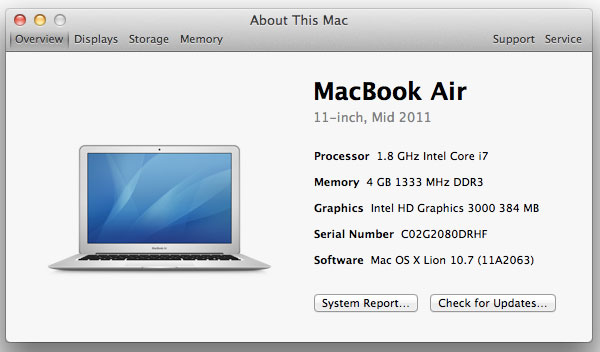
Last week we got our hands on one of these upgraded 11-inch models to find out just how much faster it is. We also wanted to find out what sort of an impact the faster CPU would have on the 11's thermals and battery life. It just so happens that our upgraded 11 gave us more than just that to investigate.
The Panel Lottery
For commodity parts within its systems Apple typically sources from two different vendors. This is done to avoid shortages due to a single component vendor. It also puts Apple in a good negotiating position. The MacBook Air is no different. Each model (11 & 13-inch) ships with one of two panels. Word on the street is that one of those panels is better than the other. It was time to find out if that's the case.
If you want to know who makes the display in your Mac and Apple hasn't overridden the EDID information from the panel simply open up terminal and execute this string:
ioreg -lw0 | grep IODisplayEDID | sed "/[^<]*</s///" | xxd -p -r | strings -6
The output will look something like this:
LP116WH4-TJA3
Color LCD
The first line is the panel's model number. Typically a quick Google search of the first few characters will give you the manufacturer's name. In this case, the LP116WH4 is made by LG Philips (hence the LP prefix). This happens to be the panel in the 11-inch Core i7 MacBook Air I just got my hands on. If you read my original review of the 2011 MBAs you'll know that both of the systems I tested there had panels by a different manufacturer:
LTH133BT01A03
LTH116AT01A04
The LT prefix on both of those part numbers implies Samsung is the OEM. The current working theory is that the LG panel in the new MacBook Air is somehow worse than the Samsung panel. Given the vast difference we saw in SSD performance between the Samsung and Toshiba drives, is it possible that Apple has allowed a similarly large gap to form between LCD vendors? Not so much:

The LG panel is slightly dimmer than the Samsung panel I originally tested.
Although you don't get peak brightness, you do get lower black levels on the LG panel:


The combination of the two actually gives us a healthy boost in max on/off contrast:
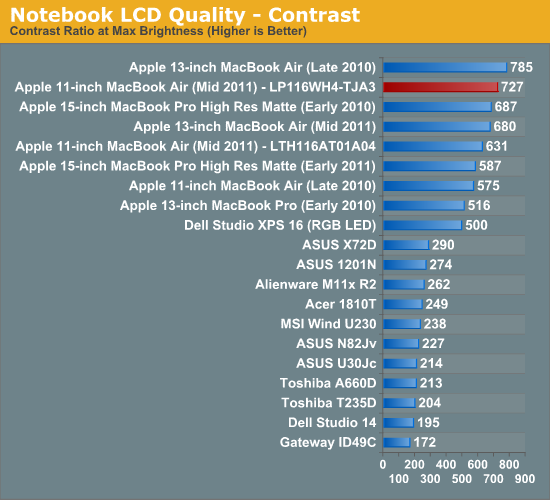
In normal usage I never noticed the increase in contrast, nor did I feel the panel was any dimmer, but there is technically an advantage here.

Color accuracy is also slightly better on the LG panel, although this small of a difference is basically impossible to notice.
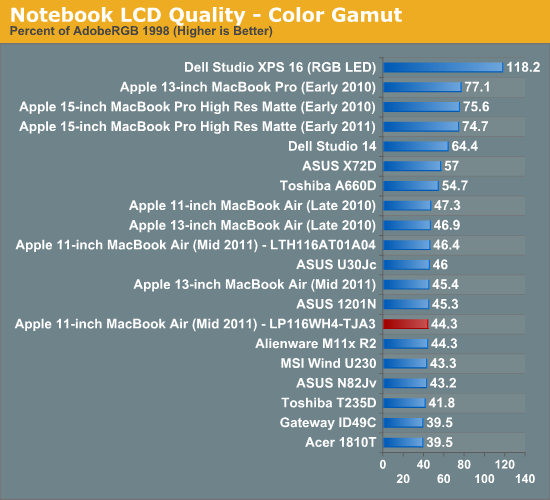
Perhaps due to backlight differences the LG panel does have a narrower color gamut.
Apple calibrates all of its systems with integrated displays before shipment so the LG panel has a similar white point to the earlier Samsung panel we tested (6700 - 6800K):

Based on these numbers alone I don't see any reason to believe that the LG panel in the new MacBook Air is any worse than the Samsung panel. However I do believe that there may be an explanation for the perceived inferior quality of the LG panel. The LG panel exhibits vertical color/contrast shift more readily than the Samsung panel. Unfortunately I don't have them both here to show you a side by side comparison but the LG panel seems to be slightly more sensitive to vertical viewing angle. As I mentioned in our original 2011 MacBook Air review, the 11 is a particularly tough system to use due to the height of its display. In order to get perpendicular line of sight to the display you need to tilt the display back and your head down. If you're off by just a few degrees you'll start to see color/contrast shift. On the LG panel that classic TN panel distortion seems to come a bit sooner than on the Samsung panel.
The issue was most noticeable to me when I had the 11 on a desk rather than on my lap. While it was particularly bothersome when I first got it, I've since become used to the display. Obviously these machines are expensive enough that I believe you should be happy with your purchase, but from my perspective the two panels are close enough that it's not worth losing sleep over. Both the LG and Samsung panels are TN panels. They may have better display characteristics than your typical cheap TN panel, but they still have the same viewing angle limitations as other TN panels. Both panels exhibit the same issues, the LG may just show them off a few degrees sooner.
The bigger problem for some is that the 11-inch MacBook Air has the highest pixel density of anything Apple ships:
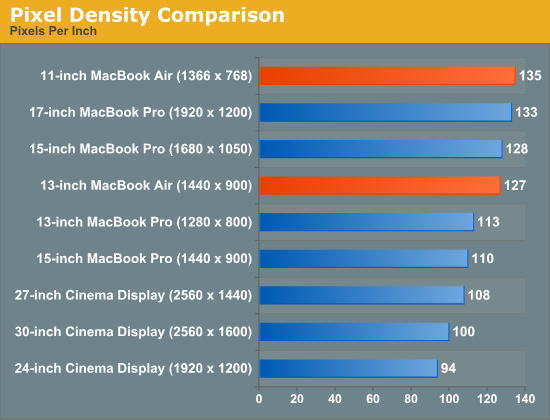
While I'm glad Apple opted for a high resolution 11-inch display, not everyone will find it easy to read. This isn't something that varies with panel type, it's just a side effect of having a small display with a high pixel density.


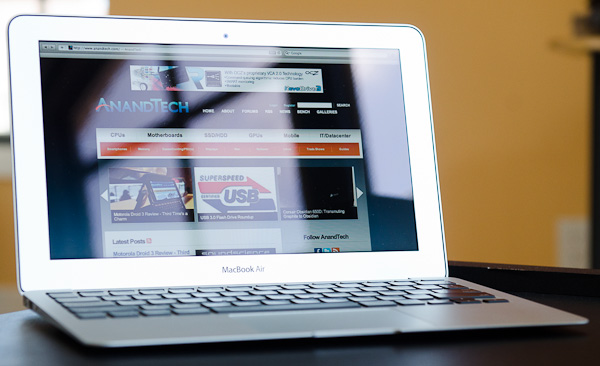

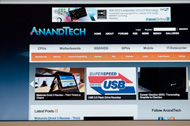
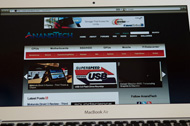








55 Comments
View All Comments
jsbruner - Monday, August 1, 2011 - link
Graphs on the performance page all show i5, should those be i7?Anand Lal Shimpi - Monday, August 1, 2011 - link
Correct - fixed :)vol7ron - Tuesday, August 2, 2011 - link
Nice article, considering purchasing my first Apple laptop to release some apps to the App Store. I'm going to give this (Air vs Pro) some more thought, since other than XCode, I probably won't be using it.Jamezrp - Monday, August 1, 2011 - link
So the i7 is a huge difference...glad I picked up that over the i5. I still got much higher numbers with Cinebench 10 than you Anand, and I'm not really sure why. Were you running any other applications when testing? I ran Win7 Ultimate on a fresh install, with 150GB dedicated to Windows. And it was a 256GB hdd, if that makes any difference.Also, all the charts show the i7 chip as an i5.
Jamezrp - Monday, August 1, 2011 - link
Oh, and my scores can be seen here, just scroll down to the charts: http://www.gadgetreview.com/2011/07/apple-macbook-...Anand Lal Shimpi - Monday, August 1, 2011 - link
You're testing under Windows 7, I'm testing under OS X :)Cinebench 10 under Windows 7 is faster than OS X, Cinebench 11.5 is relatively similar between OSes.
KPOM - Monday, August 1, 2011 - link
Thanks for the update, and with 3 days left in my 14-day return window, you have validated my decision to go with the Core i7 in my 11". I was wondering about the heat and battery life differences, and it appears they are about the same with either processor, but with a noticeable edge in performance to the i7.Also, I lucked out with a Samsung SSD. I have the LG display, but it has never bothered me. I had the 11" 2010 model with a Toshiba drive and LG display, so perhaps I was already used to the viewing angles.
Thanks for the effort. Another good review.
dagamer34 - Monday, August 1, 2011 - link
Looking at a lot of graphs in this points continually show one subtle thing, the days of the 13" MacBook Pro are numbered. At this point, there is no way I would even think to consider that laptop seeing as how the 1.8 Ghz CPU performs well against the 2.3/2.7 Ghz CPUs. CPUs are rarely pegged at 100% anyway in typical usage.My hope is that Apple extends this concept with a 15" MacBook Pro with an Air-styled body. Ditch the optical drive. Ditch rarely used ports and move all but the most necessary ports to a Thunderbolt dock. Switch from a standard 2.5" storage drive to a slimmer model to save space.
It'd be perfect. The new 15" MacBook Pro. 3.9lbs. "All the speed, none of the weight"
AssBall - Tuesday, August 2, 2011 - link
Yeah, It would sure suck to hurt yourself lugging around all of that weight......
Rasterman - Wednesday, August 3, 2011 - link
I totally agree but the only thing that sucks for me is the lack of dedicated ethernet port. I still plan on replacing my old macbook with an air though. I need a dedicated port because I do xcode development and files are over the network, when compiling each time xcode must check all files, over wireless compile time is like 1-2 minutes, but when using ethernet the time is less than 10 seconds, its a huge difference. With the air I can still use a USB to ethernet adapter though, or a thunderbolt to ethernet adapther when they come out.